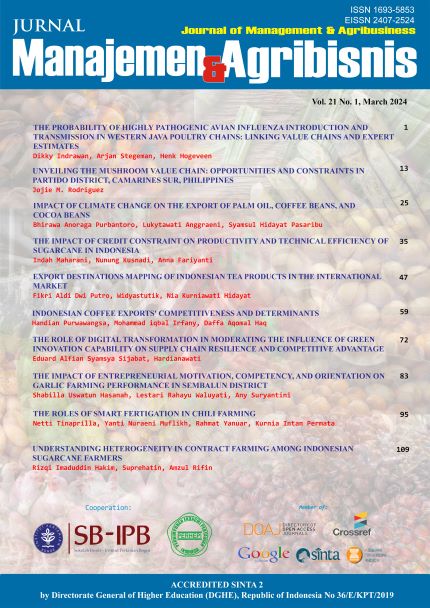The Impact of Credit Constraint on Productivity and Technical Efficiency of Sugarcane in Indonesia
Abstract
Credit constraints on banks in the sugarcane plantation sector hinder efforts to achieve sugar self-sufficiency. Farmers' access to banking is often deemed difficult due to the dominance of small-scale farmers who lack collateral. In reality, farmers who successfully access banking sources also face constraints as the amount of credit received does not match the amount requested due to information imperfections between banks and farmers. Therefore, this research aims to identify the characteristics of farmers facing credit constraints, analyze the impact of credit constraints on productivity and technical efficiency, and identify the factors influencing technical inefficiency. The sample size consists of 4885 farmers who were then analyzed using ordinal probit regression, stochastic frontier analysis (SFA), total factor productivity (TFP), partial productivity, and propensity score matching (PSM) methods. Based on the research findings, it can be concluded that land area and participation in agricultural organizations such as cooperatives and partnerships strengthen the degree of credit constraint. Meanwhile, land ownership and irrigated decrease the degree of credit constraint. The negative impact of credit constraints on productivity and technical efficiency is evident. Factors influencing technical efficiency include land status, land type, seed varieties, and participation in cooperatives and partnerships. This research has implications for bank policies that should not hinder farmers' access to banking services. This can be achieved by designing specific agricultural loans that view agriculture not as a risk but as a long-term investment.
Keywords: credit constraint, propensity score matching (PSM), stochastic frontier analysis (SFA), technical efficiency
Authors
Authors who publish with this journal agree to the following terms:
- Authors retain copyright and grant the journal right of first publication with the work simultaneously licensed under a Creative Commons Attribution License that allows others to share the work with an acknowledgement of the work's authorship and initial publication in this journal.
- Authors are able to enter into separate, additional contractual arrangements for the non-exclusive distribution of the journal's published version of the work (e.g., post it to an institutional repository or publish it in a book), with an acknowledgement of its initial publication in this journal.
- Authors are permitted and encouraged to post their work online (e.g., in institutional repositories or on their website) prior to and during the submission process, as it can lead to productive exchanges, as well as earlier and greater citation of published work (See The Effect of Open Access).

